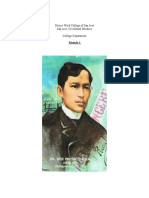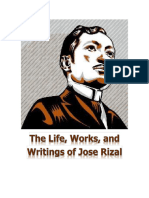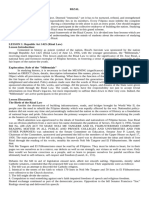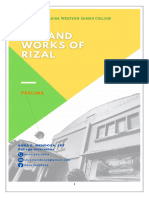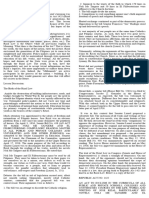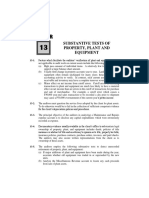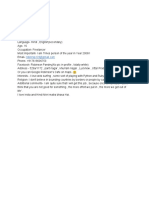0 ratings0% found this document useful (0 votes)
18 viewsWhat is Rizal Law
What is Rizal Law
Uploaded by
Alex Triñanes DonatoCopyright:
© All Rights Reserved
Available Formats
Download as DOCX, PDF, TXT or read online from Scribd
What is Rizal Law
What is Rizal Law
Uploaded by
Alex Triñanes Donato0 ratings0% found this document useful (0 votes)
18 views5 pagesCopyright
© © All Rights Reserved
Available Formats
DOCX, PDF, TXT or read online from Scribd
Share this document
Did you find this document useful?
Is this content inappropriate?
Copyright:
© All Rights Reserved
Available Formats
Download as DOCX, PDF, TXT or read online from Scribd
Download as docx, pdf, or txt
0 ratings0% found this document useful (0 votes)
18 views5 pagesWhat is Rizal Law
What is Rizal Law
Uploaded by
Alex Triñanes DonatoCopyright:
© All Rights Reserved
Available Formats
Download as DOCX, PDF, TXT or read online from Scribd
Download as docx, pdf, or txt
You are on page 1of 5
What is Rizal Law?
The Rizal Law, or Republic Act 1425, is a government-mandated law that requires
all colleges and universities in the Philippines to include courses on the life and
works of Dr. Jose Rizal, the Philippines' national hero, in their curriculums.¹
These courses also emphasize the study of Rizal's two most famous novels, "Noli
Me Tangere" and "El Filibusterismo," which are considered seminal works in
Philippine literature. This law aims to promote national consciousness and love for
country among Filipinos by studying the life and works of Rizal.²
Why Study Rizal: From The Perspective of Lawmakers
Now, you may be wondering why it is mandatory to study the life and works of
Jose Rizal. To understand the reasoning behind this, let's hear from the people
who created the Rizal Law, or Republic Act 1425, and learn their perspective on
the importance of educating students about the national hero.
In 1956, during Ramon Magsaysay's presidency, a decade had passed since the
end of World War II. At this time, many nationalist policy makers noticed that the
sense of Filipino identity seemed to be fading among the people. To address this,
the lawmakers felt it was important to focus on rebuilding a strong national
identity and moving forward as a united people.³
One of the solutions proposed by these policy makers to enhance the national
pride and hope of Filipinos was through education. In their view, by providing the
youth with a comprehensive education that included learning about their country's
history, they would become knowledgeable and proud Filipinos. This would foster
a strong sense of national identity, which in turn would lead to a stronger and
more united Philippines.
On April 3, 1956, Senator Claro M. Recto submitted a bill to the Senate Committee
on Education, which proposed that Jose Rizal's two most famous novels, Noli Me
Tangere and El Filibusterismo, be made mandatory reading for all Filipino students
in college. The bill was officially known as Senate Bill No. 438 or "An Act to Make
Noli Me Tangere and El Filibusterismo Compulsory Reading Matter in All Public and
Private Colleges and Universities, and for Other Purposes."⁴
For easier understanding, we will call it the Noli-Fili Bill.
On April 17, 1956, Senator Jose P. Laurel, who was then the Chairman of the
Committee on Education, sponsored the Noli-Fili Bill in the senate and presented it
to the upper house. According to Laurel, the main purpose of the bill is to
disseminate the ideas and ideals of Jose Rizal through the reading of his novels,
Noli Me Tangere and El Filibusterismo.⁵
"Noli Me Tangere and El Filibusterismo must be read by all Filipinos. They must be
taken to heart, for in their pages we see ourselves as a mirror, our defects as well
as our strength, our virtues as well as our vices. Only then would we become
conscious as a people, and so learn to prepare ourselves for painful sacrifices that
ultimately lead to self-reliance, self-respect and freedom."⁶
The Catholic Church's Opposition to the Noli-Fili Bill
The Noli-Fili bill, like the Reproductive Health Bill, faced opposition and
controversy from the Catholic Church and conservative groups. They opposed the
bill because it required the reading of Jose Rizal's novels, "Noli Me Tangere" and
"El Filibusterismo," which contain criticisms of the actions of the Catholic Church
during Rizal's time.
The Church argued that if the bill were to pass, it would damage the reputation of
the religion. According to Fr. Jesus Cavanna, the novels were written a long time
ago and teaching them today could be harmful as it may give students incorrect
ideas about the current state of the Philippines.⁷
Here are some additional criticisms of the Catholic Church regarding the
Noli-Fili Bill: ⁸
1.
Among the 333 pages of Noli Me Tangere, only 25 passages are nationalistic while
120 passages are anti-Catholic.
2.
170 lines from Noli Me Tangere and 50 lines in El Filibusterismo were offensive to
the Catholic doctrine.
3.
The bill might divide the nation.
4.
Compulsion to read something against one’s faith impairs freedom of speech and
religious freedom.
5.
Rizal admitted that he did not only attack the friars who acted deceptively on the
Filipinos but also the Catholic faith itself.
The Noli-Fili bill sparked a highly controversial debate. Catholic groups organized
to oppose the bill and Senator Claro M. Recto was accused of being a communist.
The situation became so tense that some Catholic schools threatened to close if
the bill were to pass.⁹
On April 19, 1956, another bill, House Bill No. 5561, was introduced in the House
of Representatives by Congressman Jacobo Z. Gonzales. This bill was almost
identical to the Noli-Fili Bill, and it also faced the same faith, as it was also
criticized and considered unconstitutional by the Church.¹⁰
The Enactment of “Rizal Law"
So what happened to the Noli-Fili bill? If the Catholic Church opposed it, why are
Rizal's works being taught in schools now? Well, Senator Jose P. Laurel proposed a
substitute bill that addressed the concerns of the Church.¹¹
Here are the few tweaks that were made to appease the opposition:
1.
The new substitute bill now included a wider range of works and writings by Jose
Rizal, instead of only "Noli Me Tangere" and "El Filibusterismo."¹²
2.
Students who did not want to read the novels were given the option to ask for an
exemption. (Note: As of now, there is no record of any student requesting an
exemption, or if such a practice was even implemented.)¹³
3.
The unexpurgated version of "Noli Me Tangere" and "El Filibusterismo" could only
be studied at the college level.¹⁴
When we say "unexpurgated version," we refer to the original version of the text
that has not been edited, censored, removed, or altered in any way. The original
meaning is retained.
You may be wondering why reading "Noli Me Tangere" and "El Filibusterismo" is
considered controversial. You might say that you read it when you were in junior
high school and it wasn't that bad. Well, maybe the reason for your perspective is
that you read the expurgated versions, which have been censored. In that case,
the true intention of the text may have been lost.
As Senator Laurel said, if we do not read the original, unedited, and uncensored
"Noli Me Tangere" and "El Filibusterismo," the purpose of the law will be lost.¹⁵
On May 12th and 14th, 1956, despite strong opposition from the Church and other
groups, Senate Bill No. 438 and House Bill No. 5561 were both approved on
second reading and in the Lower House. Then, on June 12th, 1956, on Flag Day,
President Ramon Magsaysay signed the law, which is now known as Republic Act
1425 or the Rizal Law.¹⁶
The full name of the law is "An Act to Include in the Curricula of All Public and
Private Schools, Colleges and Universities courses on the Life Works and Writings
of JOSE RIZAL, particularly his novels NOLI ME TANGERE and EL FILIBUSTERISMO,
Authorizing the Printing and Distribution Thereof, and for Other Purposes."¹⁷
Elements of the Rizal Law
According to Laurel, the purpose of enacting the Rizal Law is to educate the young
generation of the Philippines about the ideals and principles for which Rizal
sacrificed his life. By reading and studying Rizal's life, teachings, and writings, the
youth will gain confidence, direction, courage and determination to contribute to
the progress of our nation.¹⁸
Here are the different sections of Rizal Law:¹⁹
•
The first section of the law concerns mandating the students to read Rizal’s
novels.
•
The second section of the law require the schools to have a sufficient number of
copies of unexpurgated edition of the novels in their libraries.
•
The third section of the law aims to make Rizal's writings more readily available to
the general public by promoting their printing at an affordable cost, or in some
cases, providing them for free.
•
The fourth section of the law clarifies it will not change a specific section of the
Administrative Code that prohibits public school teachers from discussing religious
doctrines.
•
The fifth section of the law authorizes the unallocated funds to be used to
implement the act.
•
The last section of the law states that the act will immediately take effect.
The goal of Rizal Law can usually be summarized in three points:²⁰
1.
To rededicate the lives of youth to the ideals of freedom and nationalism, for
which our heroes lived and died.
2.
To pay tribute to our national hero for devoting his life and works in shaping the
Filipino character.
3.
To gain an inspiring source of patriotism through the study of Rizal’s life, works,
and writings.
But Really… Should We Study Rizal?
The intention of the Rizal Law is, without a doubt, good. However, I will play devil's
advocate here. All of what you read is on paper. Let's examine reality. The Rizal
Law was passed in 1956, which is a long time ago. The question remains: have its
goals been met? Or are we even close to meeting them?
The study of Rizal remains a highly debated topic to this day. And currently, the
only correct answer to why we should study Rizal is because it is the law.
You might also like
- Module 1 in Life and Works of RizalDocument17 pagesModule 1 in Life and Works of RizalJasmin Fajarit83% (12)
- Rizal Module 1Document21 pagesRizal Module 1Joresol Alorro100% (5)
- Jose Rizal's Collaborations with Other HeroesFrom EverandJose Rizal's Collaborations with Other HeroesRating: 4 out of 5 stars4/5 (6)
- American Express Case StudyDocument3 pagesAmerican Express Case StudyVarun SawhneyNo ratings yet
- 01 - Rizal - Law - Life and Works of Rizal (Notes)Document4 pages01 - Rizal - Law - Life and Works of Rizal (Notes)HumiNo ratings yet
- Intro To Rizal LawDocument61 pagesIntro To Rizal Lawnicachavez030No ratings yet
- Rizal LawDocument57 pagesRizal LawCaira Isabelle BarrettoNo ratings yet
- Lesson 1. Rizal LawDocument3 pagesLesson 1. Rizal LawLucius LukeNo ratings yet
- 01 Rizallawra1425 Lifeandworksofrizalslides 231020054956 A2561951Document53 pages01 Rizallawra1425 Lifeandworksofrizalslides 231020054956 A2561951E ENo ratings yet
- Copy-of-GEC-5-LESSON-1-PPTDocument49 pagesCopy-of-GEC-5-LESSON-1-PPTgajasa123456No ratings yet
- Module 1 - Republoic Act 1425 (Rizal Law)Document5 pagesModule 1 - Republoic Act 1425 (Rizal Law)Jonette Vela PianoNo ratings yet
- Rizal-Lesson-1 (1)Document16 pagesRizal-Lesson-1 (1)maecamino007No ratings yet
- Rizal ReviewerDocument37 pagesRizal Reviewercairajoyce218No ratings yet
- Rizal Handouts IntroductionDocument5 pagesRizal Handouts IntroductionNashralyn HadjiulaNo ratings yet
- Rizal LawDocument11 pagesRizal LawCrissanta MarceloNo ratings yet
- RA 1425 - Rizal LawDocument7 pagesRA 1425 - Rizal LawJennybabe Peta86% (7)
- Lor ReferencesDocument49 pagesLor ReferencesMD AbdullahNo ratings yet
- REPUBLIC ACT NODocument6 pagesREPUBLIC ACT NODALOGDOG, Mary Faith C. 11-AquilaNo ratings yet
- Rizal Reviewer MidtermsDocument31 pagesRizal Reviewer Midtermsvivianprimavera.vivoNo ratings yet
- The Life, Works, and Writings of Jose Rizal (Prelims)Document19 pagesThe Life, Works, and Writings of Jose Rizal (Prelims)miissjusticeNo ratings yet
- Lesson 1 RizalDocument21 pagesLesson 1 RizalLecel Honculada - LungatNo ratings yet
- Lesson 1 6 ReviewerDocument132 pagesLesson 1 6 ReviewerLeny LayaNo ratings yet
- Republic Act 1425 Rizal LawDocument2 pagesRepublic Act 1425 Rizal LawAngie TolomiaNo ratings yet
- LN-1-On-the-Rizal-Law-and-National-HeroDocument8 pagesLN-1-On-the-Rizal-Law-and-National-HeroAshley AgustinNo ratings yet
- Lesson 1 RizalDocument20 pagesLesson 1 RizalLovely Joy AutorNo ratings yet
- Unit 3 The Rizal LawDocument3 pagesUnit 3 The Rizal LawVeronika MartinNo ratings yet
- RIZALDocument8 pagesRIZALaliahayanggonzalesNo ratings yet
- Ra 1425 Rizal LawdocxDocument7 pagesRa 1425 Rizal Lawdocxjlardizabal0430No ratings yet
- Republic Act No. 1425: HistoryDocument7 pagesRepublic Act No. 1425: HistoryKarl CarlosNo ratings yet
- Life and Works of RizalDocument32 pagesLife and Works of RizalBernard CorreNo ratings yet
- The Making of Rizal Law 2Document13 pagesThe Making of Rizal Law 2John Robert Dela CruzNo ratings yet
- Chapter 01 - Rizal LawDocument19 pagesChapter 01 - Rizal LawMartus MasenaNo ratings yet
- Rizal 1Document41 pagesRizal 1landerbriomNo ratings yet
- Assignment in JRIZAL030 Summer 2020Document2 pagesAssignment in JRIZAL030 Summer 2020fabyunaaaNo ratings yet
- RizalDocument4 pagesRizalLaica CardenioNo ratings yet
- Prelim RizalDocument16 pagesPrelim RizalAireen EspinoNo ratings yet
- Module1 Life and Works of RizalDocument7 pagesModule1 Life and Works of RizalRoselyn AgustinNo ratings yet
- Module 1 GeclifDocument10 pagesModule 1 GeclifMark Dela cruzNo ratings yet
- Lesson 1 Rizal LawDocument5 pagesLesson 1 Rizal LawKriza CabilloNo ratings yet
- Gem 101life and Work of RizalDocument4 pagesGem 101life and Work of Rizaljasminerosecortez99No ratings yet
- #1 Rizal LawDocument4 pages#1 Rizal Lawsm201200631No ratings yet
- Week 1 Pre Midterm Module No. 01 Rev. 0Document23 pagesWeek 1 Pre Midterm Module No. 01 Rev. 0cocomartinNo ratings yet
- CHAPTER I Why Study RIZALDocument18 pagesCHAPTER I Why Study RIZALKristina Mae GaringoNo ratings yet
- Rizal Reviewer Midterms (Reduced)Document21 pagesRizal Reviewer Midterms (Reduced)vivianprimavera.vivoNo ratings yet
- 1-The Rizal LawDocument2 pages1-The Rizal Lawchobiipiggy26No ratings yet
- Lesson 1 Rizal LawDocument21 pagesLesson 1 Rizal LawavionaeleoraNo ratings yet
- 1-240303114939-3e06da38 (1)Document41 pages1-240303114939-3e06da38 (1)drixleigh883No ratings yet
- LIFE and WORKS of RIZALDocument5 pagesLIFE and WORKS of RIZALYOONGINo ratings yet
- Lesson 1 RizalDocument29 pagesLesson 1 RizalZandrea Gales BoracNo ratings yet
- Rizal 1Document4 pagesRizal 1H.A. S.SNo ratings yet
- UNIT 1_Lesson 1Document13 pagesUNIT 1_Lesson 1Christian Faith ColisNo ratings yet
- A5 Notes RzalDocument5 pagesA5 Notes RzalJulia Ferhyz UyNo ratings yet
- RizalDocument4 pagesRizalbraveweb136No ratings yet
- T M Zan: Ea TarDocument13 pagesT M Zan: Ea TarMajeed MajeedNo ratings yet
- RIZAL ACTIVITY 1 - Jennifer M. CastilloDocument2 pagesRIZAL ACTIVITY 1 - Jennifer M. CastilloJennifer CastilloNo ratings yet
- Module-1 The Life and Works of RizalDocument7 pagesModule-1 The Life and Works of RizalDanna Jean Halican CoedNo ratings yet
- Introduction - Ra 1425Document10 pagesIntroduction - Ra 1425Anne Aivadnem SaisonNo ratings yet
- Chapter-1-Rizal-LawDocument2 pagesChapter-1-Rizal-LawromjansugoiiNo ratings yet
- Rizal NotesDocument23 pagesRizal NotesFaith DuasoNo ratings yet
- Module in Rizal UNIT 1Document22 pagesModule in Rizal UNIT 1Dianne Mae LlantoNo ratings yet
- Module in Rizal UNIT 1Document22 pagesModule in Rizal UNIT 1Dianne Mae LlantoNo ratings yet
- Reporting in school refers to the process of presenting informationDocument8 pagesReporting in school refers to the process of presenting informationAlex Triñanes DonatoNo ratings yet
- SOLICITATION LETTERDocument1 pageSOLICITATION LETTERAlex Triñanes DonatoNo ratings yet
- retractionDocument3 pagesretractionAlex Triñanes DonatoNo ratings yet
- DonatoDocument2 pagesDonatoAlex Triñanes DonatoNo ratings yet
- lesson plan ACTIVITY -1Document3 pageslesson plan ACTIVITY -1Alex Triñanes DonatoNo ratings yet
- Module C.E. 1 LongDocument37 pagesModule C.E. 1 LongAlex Triñanes DonatoNo ratings yet
- 5 6116396517449272613Document11 pages5 6116396517449272613Angel DimapelisNo ratings yet
- R.A. 10368Document12 pagesR.A. 10368krissy liNo ratings yet
- Adobe Scan 18-Nov-2024Document4 pagesAdobe Scan 18-Nov-2024random07111No ratings yet
- Moro ProblemDocument56 pagesMoro ProblemIcas Phils100% (1)
- Ra 8423Document8 pagesRa 8423Christian Joseph OpianaNo ratings yet
- Does Nigeria Shipment Authority Check Product Sent Through Ups - Google SearchDocument1 pageDoes Nigeria Shipment Authority Check Product Sent Through Ups - Google SearchMark SilvaNo ratings yet
- Online Trading - ProjectDocument69 pagesOnline Trading - ProjectAbhijeet100% (1)
- Historical LiesDocument9 pagesHistorical LiesБС-21 Дідківська СофіяNo ratings yet
- Advert Assistant Branch Manager Mto Wa Mbu 2Document5 pagesAdvert Assistant Branch Manager Mto Wa Mbu 2Rashid BumarwaNo ratings yet
- Income Statement Problems With AnswersDocument6 pagesIncome Statement Problems With AnswerskoftaNo ratings yet
- Chapter02 - The Impact of Government Policy and Regulation On The Financial-Services IndustryDocument39 pagesChapter02 - The Impact of Government Policy and Regulation On The Financial-Services Industrytrannguyen.31231022476No ratings yet
- Chapter 13Document25 pagesChapter 13Clarize R. Mabiog50% (2)
- Assignment 2 Revenue RecognitionDocument2 pagesAssignment 2 Revenue RecognitionJuvy DimaanoNo ratings yet
- Best Property Management Software 2019Document32 pagesBest Property Management Software 2019Jason CarterNo ratings yet
- Free PayPal Accounts 2018!!Document1 pageFree PayPal Accounts 2018!!Robinson Pandey0% (1)
- Trade Secrets, Trademarks and CopyrightsDocument37 pagesTrade Secrets, Trademarks and CopyrightsvedantNo ratings yet
- Unit ObjectivesDocument120 pagesUnit ObjectivesPo LyNo ratings yet
- Lanka ClearDocument19 pagesLanka ClearRajithaNo ratings yet
- Jewish Standard, September 25, 2015Document56 pagesJewish Standard, September 25, 2015New Jersey Jewish StandardNo ratings yet
- Post-Lecture Online Quiz 5 - Corporate Finance-T323WSB-7Document6 pagesPost-Lecture Online Quiz 5 - Corporate Finance-T323WSB-722003067No ratings yet
- Atomos Limited - Investor Presentation - Oct19 FinalDocument30 pagesAtomos Limited - Investor Presentation - Oct19 FinalMaryJane WermuthNo ratings yet
- Bank Reconciliation Statement (BRS) Questions PDFDocument11 pagesBank Reconciliation Statement (BRS) Questions PDFAjitesh anandNo ratings yet
- Fascism and NazismDocument12 pagesFascism and NazismAruni SinhaNo ratings yet
- Notice 602090306Document2 pagesNotice 602090306AllyNo ratings yet
- Lesson 4 Language PolicyDocument8 pagesLesson 4 Language PolicyChristian Novhem OberioNo ratings yet
- Fpi SafDocument119 pagesFpi SafIftakar Imon100% (2)
- (2023) SCGA 30 (Revised)Document50 pages(2023) SCGA 30 (Revised)dpoet1No ratings yet
- Shop The 2CELLOS Official StoreDocument10 pagesShop The 2CELLOS Official StoreLomon SamNo ratings yet
- QIAquick Gel Extraction Kit enDocument2 pagesQIAquick Gel Extraction Kit enjvreddiNo ratings yet

